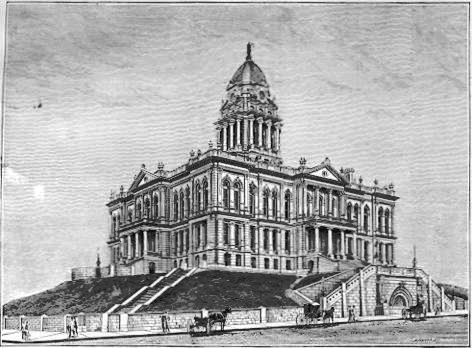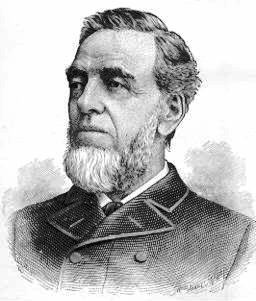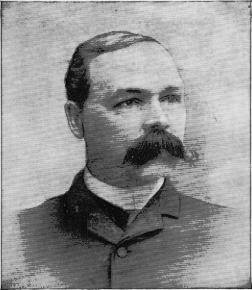|
The first
house built in Omaha was a small, rough log structure,
constructed for the ferry company. It was located in the
vicinity of Twelfth and Jackson streets, and was occupied by
Mr. and Mrs. Snowden, who kept it as a boarding house during
the summer and fall of 1854 for the ferry company's
employes. It was given the name of the St. Nicholas Hotel,
but was generally known as the "Claim House." It was in this
building that the first religious services were held in
Omaha, Sunday, August 13th, 1854, by Rev. Peter Cooper, of
Council Bluffs. The second house was built by Mr. Gaylord,
at Burt and Twenty-second streets; the third was the "Big
6," a sod house, occupied as a grocery and saloon, north
side of Chicago street, between Thirteenth and Fourteenth.
Mr. Snowden built the fourth house, a log cabin, on a lot
given 
DOUGLAS COUNTY COURT HOUSE. to him by the ferry company. It was on Tenth street, just south of Turner Hall. It was the first private dwelling house that was completed, and Mr. and Mrs. Snowden moved into it after having kept the St. Nicholas for three months. The event was celebrated with a "housewarming," and the first dance in Omaha was given on this occasion. The first brick structure was the State House, on the west side of Ninth street, between Farnam and Douglas. Margaret Ferry, born in October, 1854, daughter of James Ferry, who laid the first stone for the State House, was the first white child. This honor, however, is disputed by the friends of William Nebraska Reeves, who was born about the same time. John Logan and Miss Caroline Mosier were the first persons to form a matrimonial alliance. Mr. and Mrs. Logan still live in Omaha. William P. Snowden dug the first grave. It was for an old Otoe squaw, who had been deserted by her people. The first burial among the whites was that |
|
of M. C. Gaylord's child. Dr. George L.
Miller was Omaha's first physician. He came here in the fall
of 1854 from Syracuse, N. Y., accompanied by his father,
Col. Loren Miller, who is now 88 years of age. The first
practicing lawyers were A. J. Poppleton and O. D.
Richardson. Both came here in 1854 from Michigan.
The first steam ferry boat was the "General Marion," which superseded Brown's flat boat ferry. Omaha had a newspaper very early in her existence. It was called the "Arrow," and was printed in Council Bluffs. J. E. Johnson and J. W. Pattison were the editors and proprietors. There were only twelve issues of the Arrow, covering the period from July 28th to November 10th, 1854. Mr. Byron Reed has in his possession the whole series, with the exception of No. 6. Editor Pattison |
|||||||||
|
|
|
|

